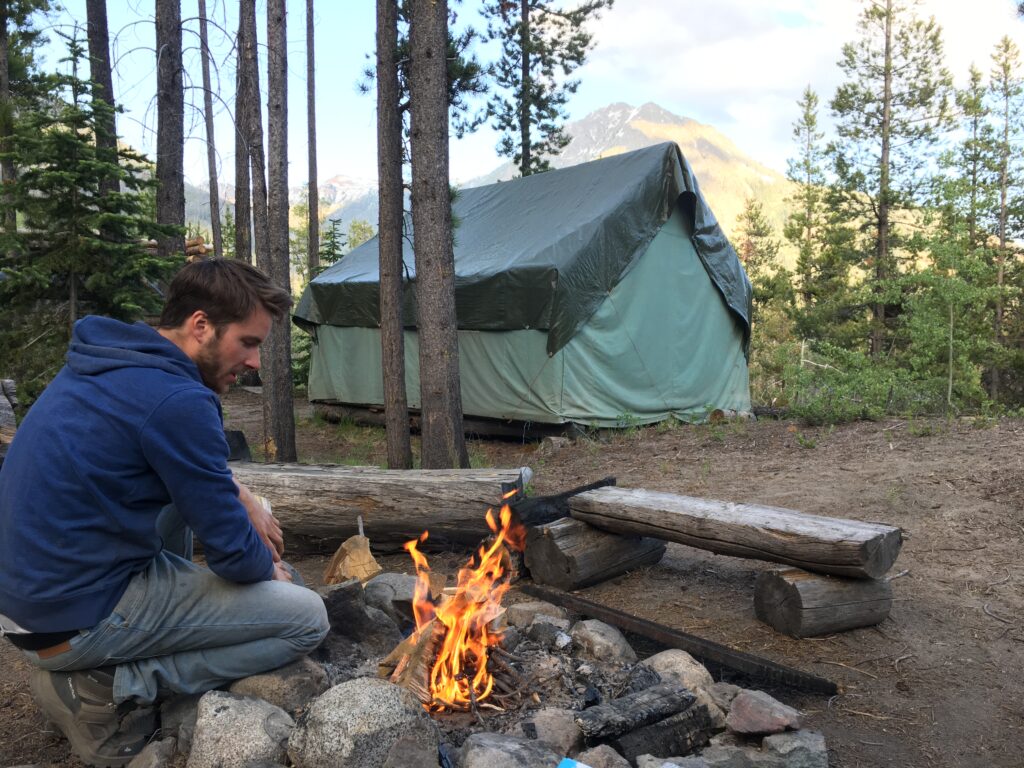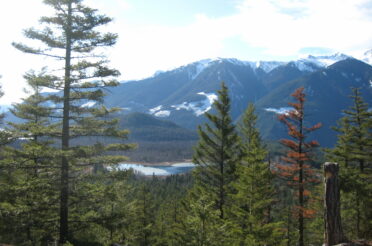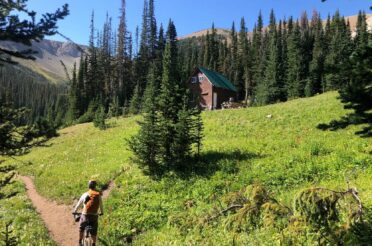My personal development – The Wood to Build a Fire

The cold weather had arrived at Brett Camp by the end of September, which meant we needed wood to build a fire in the stove. Little did I know how gathering firewood and building a fire would enhance my personal development. At 6500 feet above sea level, it was cold, freezing overnight. There was a pile of firewood maybe 100 yards to the cabin, all up hill. My challenge was to bring up all this wood , split it and build a fire with it. The logs were large, most with limbs still attached; this keeps them off the ground and helps them dry quicker.
Here was a problem I had to solve, how to untangle the logs and haul them up to the cabin. This was a great opportunity for my personal development. And that’s how we work in our community. When we have a challenge that we haven’t faced before we need to use our initiative and decision making skills to solve it, often with limited resources.
Building a travois
On my first trek back to the cabin, I took two logs, one in each hand and made my way up. I didn’t make it very far before. There must be a more efficient way of doing this. I needed a tarp, which I found quickly. I loaded it up with as many branches for kindling as would fit. Kindling is very important for building a fire. I also threw in a couple of logs, pulled all the corners together and tried to lift it as the ground was uneven. With some difficulty I maneuvered my bundle around the trees and let it down on the ground as soon as it became more even. I held the tarp behind me and hauled it along the ground by the corners. My inspiration had come from the natives’ travois.
When I returned to the Ranch, I invested in my personal development and did some more research on the travois. This is a sled-like construction made of two poles tied together to make an A-frame using cloth or leather stretched across the frame to hold goods in place. The pointed end of the two poles faces forwards, and works better than wheeled transport in areas of snow or forest floors. Using a travois, a person can transport more weight than they could carry. The poles used to make the travois were often teepee poles. This meant the teepee and additional goods could be transported. The A-frames could also be used as a fence to keep animals or as a ladder to reach the top of teepees for easier assembly.
Improving the current system
But back then I didn’t know all the details of making a travois. Which meant I stared my personal development journey with some experimenting. I tied the two back corners of my tarp together so my logs wouldn’t fall out. I knew travois were a triangle shape, but I didn’t know which way the point of the triangle faced. So my logs would not fall out, I closed the back. Now I had two corners at the front, so I could pull one with each hand. So I dragged my load up to the cabin, having to catch my breath in between. I dumped the load. Here I saw a long rope hanging outside the cabin. This inspired me to improve my travois. I attached the rope to my handles. I achieved the next step in my personal development, as it was easier to pull since I got better grip.
With my rope securely attached, I thought I’d try taking four logs at a time instead of two. I was hoping it would make me more efficient. I took the loops in my hands and started to pull. Nothing happened, it was too heavy. So I lengthened the loops to put the rope around my waist. Hoping I would have more pulling power if I used my whole body. I made it ten feet, but then the trail went steeply up hill. I pulled and pulled, but couldn’t get the tarp to move. So I took two logs out again. With just two logs in my travois, I made it back to the cabin, unloaded and went straight back to get more logs.
Using a horse – not a good idea
As I brought up more loads, I thought about how I could improve this system further. Using a horse. That seemed the most logical. Apache was already saddled with the pack saddle. So I walked him over to the tarp. When he saw the tarp, he stopped and wouldn’t move. I gently encouraged him to walk passed the tarp and turn around. He eyed it warily, then jumped around it. He walked back passed it, but he was still nervous. This was probably where I should have chosen not to use Apache. But as I tied on the first rope end, he stood quietly. Then, I took the other end and walked behind him to tie it on. Having the tarp behind him was too much. Apache bolted, galloping away towards the meadow with my travois attached only on one side.
Half way up the hill, two of the logs fell out. He lost the other two almost right beside the cabin. I chased after him trying not to spook him any more, hoping he’d stop when he reached the other horses grazing up the hillside. When he reached the first meadow, he stopped. He stood frozen, looking at me as if to say ‘Help me!’. I walked over to him, talking to him softly and stroking his nose to calm him down. When he was calmer and whickering again I untied the rope and led Apache back to the corral. He followed me a little nervously. I told him I was sorry for scaring him. Apache was the wrong horse to use. I learned a valuable lesson as part of my personal development. So I continued to bring the next load of logs up by hand.
Another challenge: Snow
The next day was a blizzard. This seemed like the perfect opportunity to bring up the rest of the logs. My travois had become a sled. I thought it would be easier to drag it over snow. So, I loaded up again, found I could still only drag two logs at a time. Yesterday, I’d brought up perhaps a third of the logs and it had taken me an hour. At first, the snow did make it easier and I worked quickly. But then my trail started to turn from snow to ice. I was wearing rubber boots to keep my feet dry, but it meant I had no grip. As the trail got more compacted, I slipped. Falling down again and again. After that I walked up the side of the trail, in the soft snow. It was easier, but pulling the logs was still a challenge.
I was determined to bring up all the logs, however many trips it took me. My inspiration to keep going was Manon, another of our guides. Manon wouldn’t quit until the job was done. It didn’t matter how difficult it was. She would always work with a positive attitude. Beyond that, I wanted to prove I could do it, both to myself and everyone else. I wanted to work on my personal development. It was a test of determination and mental and physical stamina. It was also empowering. When I was finished I took a photo of all the logs by the cabin. I had done all this by myself. I’d worked out for myself how to bring the logs up, refined my method, learned from trial and error and got the job done. The wood to build a fire was my personal development journey.
Splitting the wood
Now, I had to split the wood. Although I knew how to chop wood, it always took me a long time, my accuracy and technique needed improving. Now was the perfect opportunity to practice, I had a lot of wood to work with. There were four different axes here, a hatchet, a small axe, a full sized axe and a splitting maul. I started with the smaller axe, thinking it was sharper and would be easier. The first few logs split, I thought the small axe was working well, but I was hacking at my fourth log, making no progress. I swapped for the splitting maul, and realized how much easier it was, the blade made a wider split in the log, so it was easier to finish the job.
Several times, I even split logs in half on my first swing, something I’d never done before. I was feeling even more empowered, I was good at this, I’d improved my splitting abilities tenfold. I soon had a large pile of split wood ready to dry out on the porch for a few days. Dale explained to me the difference between wet wood (green wood) and wood wet from snow or rain. Wet wood was new wood, it wouldn’t burn well because the tree had only been recently felled. Wood wet from snow was dry inside, with a few days to dry out of the snow, it would burn fine.
Firewood that does not burn
But the adventure wasn’t over yet. Even after a couple of days drying, the wood still wouldn’t burn. Trying to keep the fire going became a daily challenge for us, but we didn’t give up and were determined to make it work. I spent a lot of time doubting my fire-starting abilities, but as a team, we kept the fire burning, although we did have to relight it multiple times a day.
Kevan arrived at camp a week into our trip and asked me why I hadn’t done anything about the wood situation. I thought I’d done a lot, bringing up all the wood, splitting it and getting it to burn. I hadn’t even thought of Kevan’s solution – use different wood. The wood wasn’t burning badly because of the snow, it was just bad wood. So before dinner, we went out to find a dead tree to fall. We found one and cut it. We dragged the wood up together in a tarp and started splitting it. The fire burned so hot and well the next morning we woke up sweating. Over the next few days, we found and cut more trees, hauled them up to the cabin and split the wood. Now, we had no shortage of good firewood, which would keep us going through the next few weeks.
My personal development
Here I learned to think outside the box. There’s always a solution to a problem and doing the same thing over and over, hoping for a better result, thinking it’s the only option isn’t productive, in fact, it’s the definition of insanity! Sometimes you think you have all the options but then someone else steps in from outside and you realize you couldn’t see the forest for the trees. Sometimes, you need to step back from the situation and look at it from a different angle. That’s the mindset we have, everything’s possible, there are no excuses, there’s always a solution but you need to be able to think through all the options and look at a situation from every angle. And most importantly, never give up. Successfully overcoming a struggle and challenge is a real achievement.I learned



